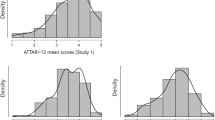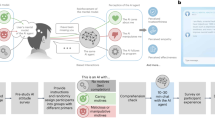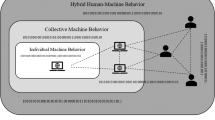Abstract
What are the psychological factors driving attitudes toward artificial intelligence (AI) tools, and how can resistance to AI systems be overcome when they are beneficial? Here we first organize the main sources of resistance into five main categories: opacity, emotionlessness, rigidity, autonomy and group membership. We relate each of these barriers to fundamental aspects of cognition, then cover empirical studies providing correlational or causal evidence for how the barrier influences attitudes toward AI tools. Second, we separate each of the five barriers into AI-related and user-related factors, which is of practical relevance in developing interventions towards the adoption of beneficial AI tools. Third, we highlight potential risks arising from these well-intentioned interventions. Fourth, we explain how the current Perspective applies to various stakeholders, including how to approach interventions that carry known risks, and point to outstanding questions for future work.
This is a preview of subscription content, access via your institution
Access options
Access Nature and 54 other Nature Portfolio journals
Get Nature+, our best-value online-access subscription
$29.99 / 30 days
cancel any time
Subscribe to this journal
Receive 12 digital issues and online access to articles
$119.00 per year
only $9.92 per issue
Buy this article
- Purchase on Springer Link
- Instant access to full article PDF
Prices may be subject to local taxes which are calculated during checkout
Similar content being viewed by others
References
Beal, G. M. & Bohlen, J. M. The Diffusion Process (Iowa State Agricultural Experiment Station Special Report no. 18), https://ageconsearch.umn.edu/record/17351/files/ar560111.pdf (Iowa State Univ., 1956).
Bass, F. M. A new product growth for model consumer durables. Manag. Sci. 15, 215–227 (1969).
Rogers, E. M. Diffusion of Innovations (Free Press of Glencoe, 1962).
Meehl, P. E. Clinical Versus Statistical Prediction: A Theoretical Analysis and a Review of the Evidence (Univ. Minnesota Press, 1954).
Lehmann, C. A., Haubitz, C. B., Fügener, A. & Thonemann, U. W. The risk of algorithm transparency: how algorithm complexity drives the effects on the use of advice. Prod. Oper. Manag. 31, 3419–3434 (2022).
Highhouse, S. Stubborn reliance on intuition and subjectivity in employee selection. Ind. Organ. Psychol. 1, 333–342 (2008).
Beck, A. H. et al. Systematic analysis of breast cancer morphology uncovers stromal features associated with survival. Sci. Transl. Med. 3, 108ra113 (2011).
Wischnewski, M., Krämer, N. & Müller, E. Measuring and understanding trust calibrations for automated systems: a survey of the state-of-the-art and future directions. In Proc. 2023 CHI Conf. on Human Factors in Computing Systems (eds. Schmidt, A. et al.) 755, 1–16 (ACM, 2023).
Averill, J. R. Personal control over aversive stimuli and its relationship to stress. Psychol. Bull. 80, 286–303 (1973).
Burger, J. M. & Cooper, H. M. The desirability of control. Motiv. Emot. 3, 381–393 (1979).
Ahn, W.-K., Novick, L. R. & Kim, N. S. Understanding behavior makes it more normal. Psychon. Bull. Rev. 10, 746–752 (2003).
Pennington, N. & Hastie, R. Explaining the evidence: tests of the Story Model for juror decision making. J. Personal. Soc. Psychol. 62, 189 (1992).
Legare, C. H. Exploring explanation: explaining inconsistent evidence informs exploratory, hypothesis‐testing behavior in young children. Child Dev. 83, 173–185 (2012).
Wong, W.-h & Yudell, Z. A normative account of the need for explanation. Synthese 192, 2863–2885 (2015).
De Freitas, J. & Johnson, S. G. Optimality bias in moral judgment. J. Exp. Soc. Psychol. 79, 149–163 (2018).
Misztal, B. A. Normality and trust in Goffman’s theory of interaction order. Sociol. Theory 19, 312–324 (2001).
Burrell, J. How the machine ‘thinks’: understanding opacity in machine learning algorithms. Big Data Soc. 3, 2053951715622512 (2016).
Castelo, N. Understanding and improving consumer reactions to service bots. J. Consumer Res. https://doi.org/10.1093/jcr/ucad023 (2023).
Nussberger, A.-M., Luo, L., Celis, L. E. & Crockett, M. J. Public attitudes value interpretability but prioritize accuracy in artificial intelligence. Nat. Commun. 13, 5821 (2022).
Beller, J., Heesen, M. & Vollrath, M. Improving the driver–automation interaction: an approach using automation uncertainty. Hum. Factors 55, 1130–1141 (2013).
Koo, J. et al. Why did my car just do that? Explaining semi-autonomous driving actions to improve driver understanding, trust and performance. Int. J. Interact. Des. Manuf. (IJIDeM) 9, 269–275 (2015).
Kraus, J., Scholz, D., Stiegemeier, D. & Baumann, M. The more you know: trust dynamics and calibration in highly automated driving and the effects of take-overs, system malfunction and system transparency. Hum. Factors 62, 718–736 (2020).
Cadario, R., Longoni, C. & Morewedge, C. K. Understanding, explaining and utilizing medical artificial intelligence. Nat. Hum. Behav. 5, 1636–1642 (2021).
Confalonieri, R., Coba, L., Wagner, B. & Besold, T. R. A historical perspective of explainable artificial intelligence. Wiley Interdiscip. Rev. Data Min. Knowl. Discov. 11, e1391 (2021).
Kim, D. et al. How should the results of artificial intelligence be explained to users? Research on consumer preferences in user-centered explainable artificial intelligence. Technol. Forecast. Soc. Change 188, 122343 (2023).
Larasati, R., De Liddo, A. & Motta, E. The effect of explanation styles on user’s trust. In ExSS-ATEC 2020: Explainable Smart Systems for Algorithmic Transparency in Emerging Technologies (eds. Smith-Renner, A. et al.) https://ceur-ws.org/Vol-2582/paper6.pdf (CEUR-WS, 2020).
Nisbett, R. E. & Wilson, T. D. Telling more than we can know: verbal reports on mental processes. Psychol. Rev. 84, 231–259 (1977).
Kahneman, D. Maps of bounded rationality: psychology for behavioral economics. Am. Econ. Rev. 93, 1449–1475 (2003).
Morewedge, C. K. & Kahneman, D. Associative processes in intuitive judgment. Trends Cogn. Sci. 14, 435–440 (2010).
Waytz, A., Cacioppo, J. & Epley, N. Who sees human? The stability and importance of individual differences in anthropomorphism. Perspect. Psychol. Sci. 5, 219–232 (2010).
Epley, N., Waytz, A. & Cacioppo, J. T. On seeing human: a three-factor theory of anthropomorphism. Psychol. Rev. 114, 864–886 (2007).
Jacobs, O. L., Gazzaz, K. & Kingstone, A. Mind the robot! Variation in attributions of mind to a wide set of real and fictional robots. Int. J. Soc. Robot. 14, 529–537 (2022).
Castelo, N., Bos, M. W. & Lehmann, D. R. Task-dependent algorithm aversion. J. Mark. Res. 56, 809–825 (2019).
Kodra, E., Senechal, T., McDuff, D. & El Kaliouby, R. From dials to facial coding: automated detection of spontaneous facial expressions for media research. In Proc. 2013 10th IEEE International Conference and Workshops on Automatic Face and Gesture Recognition (FG) 1–6 (IEEE, 2013).
Ramesh, A., Dhariwal, P., Nichol, A., Chu, C. & Chen, M. Hierarchical text-conditional image generation with clip latents. Preprint at https://arxiv.org/abs/2204.06125 (2022).
Liu, B., Fu, J., Kato, M. P. & Yoshikawa, M. Beyond narrative description: generating poetry from images by multi-adversarial training. In Proc. 26th ACM International Conference on Multimedia 783–791 (ACM, 2018).
Hernandez-Olivan, C. & Beltran, J. R. Music composition with deep learning: a review. In Advances in Speech and Music Technology: Computational Aspects and Applications (eds. Biswas, A., Wennekes, E., Wieczorkowaska, A., & Laskar, R.H.) 25–50 (Springer International, 2023).
Yeomans, M., Shah, A., Mullainathan, S. & Kleinberg, J. Making sense of recommendations. J. Behav. Decis. Mak. 32, 403–414 (2019).
Herremans, D., Martens, D. & Sörensen, K. Dance hit song prediction. J. N. Music Res. 43, 291–302 (2014).
Inbar, Y., Cone, J. & Gilovich, T. People’s intuitions about intuitive insight and intuitive choice. J. Pers. Soc. Psychol. 99, 232–247 (2010).
Crowley, A. E., Spangenberg, E. R. & Hughes, K. R. Measuring the hedonic and utilitarian dimensions of attitudes toward product categories. Mark. Lett. 3, 239–249 (1992).
Hirschman, E. C. & Holbrook, M. B. Hedonic consumption: emerging concepts, methods and propositions. J. Mark. 46, 92–101 (1982).
Longoni, C. & Cian, L. Artificial intelligence in utilitarian vs hedonic contexts: the ‘word-of-machine’ effect. J. Mark. 86, 91–108 (2022).
Waytz, A., Heafner, J. & Epley, N. The mind in the machine: anthropomorphism increases trust in an autonomous vehicle. J. Exp. Soc. Psychol. 52, 113–117 (2014).
Li, S., Peluso, A. M. & Duan, J. Why do we prefer humans to artificial intelligence in telemarketing? A mind perception explanation. J. Retail. Consum. Serv. 70, 103139 (2023).
Holthöwer, J. & van Doorn, J. Robots do not judge: service robots can alleviate embarrassment in service encounters. J. Acad. Mark. Sci. 51, 767–784 (2022).
Pitardi, V., Wirtz, J., Paluch, S. & Kunz, W. H. Service robots, agency and embarrassing service encounters. J. Serv. Manag. 33, 389–414 (2021).
Hong, Y.-y., Chiu, C.-y. & Dweck, C. S. Implicit theories of intelligence: reconsidering the role of confidence in achievement motivation. In Efficacy, Agency and Self-Esteem (ed. Kernis, M.H.) 197–216 (Springer, 1995).
Hancock, P. A. Imposing limits on autonomous systems. Ergonomics 60, 284–291 (2017).
McClean, T. The Path from Automation to Autonomy is Swarming with Activity, https://www.forbes.com/sites/forbestechcouncil/2021/04/01/the-path-from-automation-to-autonomy-is-swarming-with-activity/?sh=134ca90f3716 (Forbes, 2021).
Reich, T., Kaju, A. & Maglio, S. J. How to overcome algorithm aversion: learning from mistakes. J. Consum. Psychol. 33, 285–302 (2022).
Loughnan, S. & Haslam, N. Animals and androids: implicit associations between social categories and nonhumans. Psychol. Sci. 18, 116–121 (2007).
Berger, B., Adam, M., Rühr, A. & Benlian, A. Watch me improve—algorithm aversion and demonstrating the ability to learn. Bus. Inf. Syst. Eng. 63, 55–68 (2021).
Nissenbaum, H. & Walker, D. Will computers dehumanize education? A grounded approach to values at risk. Technol. Soc. 20, 237–273 (1998).
Longoni, C., Bonezzi, A. & Morewedge, C. K. Resistance to medical artificial intelligence. J. Consum. Res. 46, 629–650 (2019).
Mou, Y., Xu, T. & Hu, Y. Uniqueness neglect on consumer resistance to AI. Market. Intell. Plan. 41, 669–689 (2023).
Purcell, Z. A. & Bonnefon, J.-F. Humans feel too special for machines to score their morals. PNAS Nexus 2, pgad179 (2023).
Liu, N. T. Y., Kirshner, S. N. & Lim, E. T. Is algorithm aversion WEIRD? A cross-country comparison of individual-differences and algorithm aversion. J. Retail. Consum. Serv. 72, 103259 (2023).
Yampolskiy, R. V. Unpredictability of AI: on the impossibility of accurately predicting all actions of a smarter agent. J. Artif. Intell. Conscious. 7, 109–118 (2020).
De Freitas, J., Uǧuralp, K., Uǧuralp, Z. O. & Puntoni, S. Chatbots and Mental Health: Insights into the Safety of Generative AI Working Paper 23-011 (Harvard Business School, 2023).
Leotti, L. A., Iyengar, S. S. & Ochsner, K. N. Born to choose: the origins and value of the need for control. Trends Cogn. Sci. 14, 457–463 (2010).
Bandura, A. Self-efficacy: The Exercise of Control (W. H. Freeman, 1997).
Rotter, J. B. Generalized expectancies of internal versus external control of reinforcements. Psychol. Monogr. 80, 609 (1966).
Ryan, R. M. & Deci, E. L. Self‐regulation and the problem of human autonomy: does psychology need choice, self‐determination and will? J. Personal. 74, 1557–1586 (2006).
Bown, N. J., Read, D. & Summers, B. The lure of choice. J. Behav. Decis. Mak. 16, 297–308 (2003).
Suzuki, S. Effects of number of alternatives on choice in humans. Behav. Process. 39, 205–214 (1997).
Cordova, D. I. & Lepper, M. R. Intrinsic motivation and the process of learning: beneficial effects of contextualization, personalization and choice. J. Educ. Psychol. 88, 715–730 (1996).
Shapiro, D. H. Jr, Schwartz, C. E. & Astin, J. A. Controlling ourselves, controlling our world: psychology’s role in understanding positive and negative consequences of seeking and gaining control. Am. Psychol. 51, 1213–1230 (1996).
Premack, D. The infant’s theory of self-propelled objects. Cognition 36, 1–16 (1990).
Beer, J. M., Fisk, A. D. & Rogers, W. A. Toward a framework for levels of robot autonomy in human-robot interaction. J. Hum. Robot Interact. 3, 74–99 (2014).
De Bellis, E. & Johar, G. V. Autonomous shopping systems: identifying and overcoming barriers to consumer adoption. J. Retail. 96, 74–87 (2020).
Schweitzer, F. & Van den Hende, E. A. To be or not to be in thrall to the march of smart products. Psychol. Mark. 33, 830–842 (2016).
Mandler, J. M. How to build a baby: II. Conceptual primitives. Psychol. Rev. 99, 587–604 (1992).
Leslie, A. M. ToMM, ToBy, and Agency: Core architecture and domain specificity. In Mapping the Mind: Domain Specificity in Cognition and Culture (eds. Hirschfeld, L.A. & Gelman, S.A.) 119–148 (Cambridge Univ. Press, 1994).
Dennett, D. C. The Intentional Stance (MIT Press, 1989).
Gergely, G. & Csibra, G. Teleological reasoning in infancy: the naïve theory of rational action. Trends Cogn. Sci. 7, 287–292 (2003).
Rijsdijk, S. A. & Hultink, E. J. ‘Honey, have you seen our hamster?’ Consumer evaluations of autonomous domestic products. J. Prod. Innov. Manag. 20, 204–216 (2003).
Wertenbroch, K. et al. Autonomy in consumer choice. Mark. Lett. 31, 429–439 (2020).
André, Q. et al. Consumer choice and autonomy in the age of artificial intelligence and big data. Customer Needs Solut. 5, 28–37 (2018).
Brennan, R. & Sachon, L. Self-Driving Cars Make 76% of Americans Feel Less Safe on the Road, https://www.policygenius.com/auto-insurance/self-driving-cars-survey-2022/ (Policy Genius, 2022).
Zimmermann, J. L., Görgen, J., de Bellis, E., Hofstetter, R. & Puntoni, S. Smart product breakthroughs depend on customer control. MIT Sloan Management Review (16 February 2023).
Zimmermann, J. L., de Bellis, E., Hofstetter, R. & Puntoni, S. Cleaning with Dustin Bieber: Nicknaming Autonomous Products and the Effect of Coopetition. In Proc. TMS 2021.
Shaffer, V. A., Probst, C. A., Merkle, E. C., Arkes, H. R. & Medow, M. A. Why do patients derogate physicians who use a computer-based diagnostic support system? Med. Decis. Mak. 33, 108–118 (2013).
Oyserman, D. Identity-based motivation: implications for action-readiness, procedural-readiness and consumer behavior. J. Consum. Psychol. 19, 250–260 (2009).
Cheng, P. W. & Novick, L. R. A probabilistic contrast model of causal induction. J. Personal. Soc. Psychol. 58, 545–567 (1990).
Menon, T., Morris, M. W., Chiu, C.-Y. & Hong, Y.-Y. Culture and the construal of agency: attribution to individual versus group dispositions. J. Personal. Soc. Psychol. 76, 701–717 (1999).
Leung, E., Paolacci, G. & Puntoni, S. Man versus machine: resisting automation in identity-based consumer behavior. J. Mark. Res. 55, 818–831 (2018).
de Bellis, E., Johar, G. V. & Poletti, N. Meaning of manual labor impedes consumer adoption of autonomous products. J. Market. https://doi.org/10.1177/00222429231171841 (2023).
Inzlicht, M., Shenhav, A. & Olivola, C. Y. The effort paradox: effort is both costly and valued. Trends Cogn. Sci. 22, 337–349 (2018).
Norton, M. I., Mochon, D. & Ariely, D. The IKEA effect: when labor leads to love. J. Consum. Psychol. 22, 453–460 (2012).
Lim, J. S. & O’Connor, M. Judgemental adjustment of initial forecasts: its effectiveness and biases. J. Behav. Decis. Mak. 8, 149–168 (1995).
Dietvorst, B. J., Simmons, J. P. & Massey, C. Overcoming algorithm aversion: people will use imperfect algorithms if they can (even slightly) modify them. Manag. Sci. 64, 1155–1170 (2018).
Landsbergen, D., Coursey, D. H., Loveless, S. & Shangraw, R. Jr Decision quality, confidence and commitment with expert systems: an experimental study. J. Public Adm. Res. Theory 7, 131–158 (1997).
Caviola, L., Everett, J. A. & Faber, N. S. The moral standing of animals: towards a psychology of speciesism. J. Personal. Soc. Psychol. 116, 1011–1029 (2019).
Schmitt, B. Speciesism: an obstacle to AI and robot adoption. Mark. Lett. 31, 3–6 (2020).
Mori, M. The uncanny valley. Energy 7, 33–35 (1970).
Kamide, H., Kawabe, K., Shigemi, S. & Arai, T. Anshin as a concept of subjective well-being between humans and robots in Japan. Adv. Robot. 29, 1624–1636 (2015).
Dang, J. & Liu, L. Robots are friends as well as foes: ambivalent attitudes toward mindful and mindless AI robots in the United States and China. Comput. Hum. Behav. 115, 106612 (2021).
Biden–Harris Administration Announces New Actions to Promote Responsible AI Innovation that Protects Americans’ Rights and Safety, https://www.whitehouse.gov/briefing-room/statements-releases/2023/05/04/fact-sheet-biden-harris-administration-announces-new-actions-to-promote-responsible-ai-innovation-that-protects-americans-rights-and-safety/ (White House, 2023).
Combatting Online Harms Through Innovation, https://www.ftc.gov/system/files/ftc_gov/pdf/Combatting%20Online%20Harms%20Through%20Innovation%3B%20Federal%20Trade%20Commission%20Report%20to%20Congress.pdf (FTC, 2022).
Fung, P. Etienne, H. Confucius, cyberpunk and Mr. Science: comparing AI ethics principles between China and the EU. AI Ethics 3 505–511 (2023).
Dietvorst, B. J., Simmons, J. P. & Massey, C. Algorithm aversion: people erroneously avoid algorithms after seeing them err. J. Exp. Psychol. Gen. 144, 114–126 (2015).
Rozenblit, L. & Keil, F. The misunderstood limits of folk science: an illusion of explanatory depth. Cogn. Sci. 26, 521–562 (2002).
Morewedge, C. K. Preference for human, not algorithm aversion. Trends Cogn. Sci. 26, 824–826 (2022).
Johnson, C. & Tyson, A. People Globally Offer Mixed Views of the Impact of Artificial Intelligence, Job Automation on Society, https://www.pewresearch.org/short-reads/2020/12/15/people-globally-offer-mixed-views-of-the-impact-of-artificial-intelligence-job-automation-on-society/ (Pew Research Center, 2020).
Bostrom, N. Superintelligence: Paths, Dangers, Strategies (Oxford Univ. Press, 2014).
Zhang, C. et al. One small step for generative AI, one giant leap for AGI: a complete survey on ChatGPT in AIGC era. Preprint at https://arxiv.org/abs/2304.06488 (2023).
Purcell, Z. A., Dong, M., Nussberger, A.-M., Köbis, N. & Jakesch, M. Fears about AI-mediated communication are grounded in different expectations for one’s own versus others’ use. Preprint at https://arxiv.org/abs/2305.01670 (2023).
Chan, A., Riché, M. & Clifton, J. Towards the scalable evaluation of cooperativeness in language models. Preprint at https://arxiv.org/abs/2303.13360 (2023).
Köbis, N., Starke, C. & Rahwan, I. The promise and perils of using artificial intelligence to fight corruption. Nat. Mach. Intell. 4, 418–424 (2022).
Davis, F. D., Bagozzi, R. P. & Warshaw, P. R. User acceptance of computer technology: a comparison of two theoretical models. Manag. Sci. 35, 982–1003 (1989).
Ram, S. A model of innovation resistance. Adv. Consum. Res. 14, 208–212 (1987).
Author information
Authors and Affiliations
Corresponding author
Ethics declarations
Competing interests
The authors declare no competing interests.
Peer review
Peer review information
Nature Human Behaviour thanks Zoe Purcell and the other, anonymous, reviewer(s) for their contribution to the peer review of this work.
Additional information
Publisher’s note Springer Nature remains neutral with regard to jurisdictional claims in published maps and institutional affiliations.
Rights and permissions
Springer Nature or its licensor (e.g. a society or other partner) holds exclusive rights to this article under a publishing agreement with the author(s) or other rightsholder(s); author self-archiving of the accepted manuscript version of this article is solely governed by the terms of such publishing agreement and applicable law.
About this article
Cite this article
De Freitas, J., Agarwal, S., Schmitt, B. et al. Psychological factors underlying attitudes toward AI tools. Nat Hum Behav 7, 1845–1854 (2023). https://doi.org/10.1038/s41562-023-01734-2
Received:
Accepted:
Published:
Issue Date:
DOI: https://doi.org/10.1038/s41562-023-01734-2
This article is cited by
-
Protect our environment from information overload
Nature Human Behaviour (2024)
-
Artificial intelligence and illusions of understanding in scientific research
Nature (2024)



